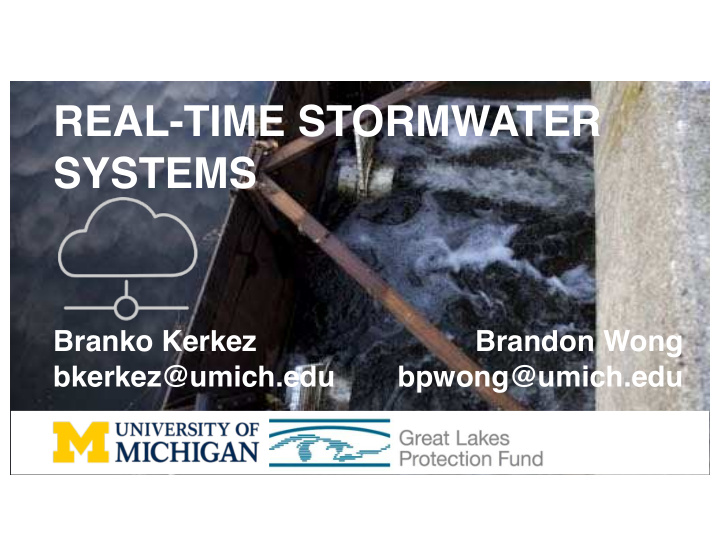



REAL-TIME STORMWATER SYSTEMS Branko Kerkez Brandon Wong bkerkez@umich.edu bpwong@umich.edu
Iot Information age
10 sq mi 9
Pond 10 sq mi 10
Pond 10 sq mi Bioswale 11
Pond 10 sq mi Bioswale 12
1 Pond 2 10 sq mi Bioswale 13
Pre-construction Post-construction Water level, erosion, etc. D 1 2 Time
Pre-construction Site 1 Post-construction Water level, erosion, etc. D 1 2 Time
Pre-construction Site 1 Post-construction Water level, erosion, etc. D Site 2 1 2 Time
Pre-construction Site 1 Post-construction Water level, erosion, etc. D Site 2 1 2 Downstream Time
Pre-construction Site 1 Post-construction Better Water level, erosion, etc. D Site 2 1 2 Downstream Time
Pre-construction Site 1 Post-construction Better Water level, erosion, etc. D Site 2 Better 1 2 Downstream Time
Pre-construction Site 1 Post-construction Better Water level, erosion, etc. + D Site 2 Better 1 = 2 Downstream Worse? Time
! Smart ponds adapt to changing Rain, soil moisture and water weather by managing storage quality sensors measure and detention time real-time conditions of green and gray infrastructure Smart covers measure Multiple smart valves underground flows and coordinate flows to water quality achieve system-level benefits
OPEN-STORM.ORG 23
24
Water level Flooding/Erosion Neighborhood 2 Neighborhood 1 Time Downstream point
Without Controller Control With Control Water level Flooding/Erosion Neighborhood 2 Neighborhood 1 Time Downstream point
27
Ellsworth
29
30
31
32
33
Basin Wetland
Basin Wetland
• Before • 15 Million Gallons Storage • $22/gal • 600 lb/yr Total P 50% Increase in Capacity After • 22.5 million Gallons • $16/gal • 800 lb/yr Total P
does it scale?
Open-Storm Detroit Dynamics Utility-University Team Wendy Christopher Gregory Abhiram Sara Branko Barrott Nastally Ewing Mullapudi Troutman Kerkez
The Opportunity 100+ 20+ Control Sensors Points
The Plan
The Plan $131K
The Plan $131K
The Plan Nov 2017 – Nov 2018 Outcomes & Considerations $131K 1. No New Construction 2. Maximize Storage 3. Reduce CSOs 4. Equalize Flows
Existing SCADA Workflow Sensors
Existing SCADA Workflow Utility Sensors Server
Existing SCADA Workflow Utility Raw Data Sensors Server Feeds
Existing SCADA Workflow Utility Raw Data Pumps Sensors Server Feeds Valves
Existing SCADA Workflow Utility Raw Data Pumps Sensors Server Feeds Valves
Description of Smart Water System Analytics and Control Pumps Sensors Utility Server Visualization Valves
Description of Smart Water System Quality Pumps Sensors Utility Server Visualization Valves Control
Description of Smart Water System Quality Control Pumps Sensors Utility Server Visualization Valves Control Engine
Description of Smart Water System Quality Control Decision Pumps Sensors Utility Server Visualization Valves Control Engine Dashboard
Description of Smart Water System Quality Control Decision Pumps Sensors Utility Server Visualization Valves Control Engine Dashboard
RAW WATER LEVEL DATA Water Level (mm) Real-time QA/QC Water Level (mm) Time
Real-Time Forecasting PySWMM RADAR Hydraulic Model
Existing Challenge
Existing Challenge
Existing Challenge
Existing Challenge
Implementation ! " = $ " ⋅ & '(," * = & +,-. − 01234562 ⋅ 7 1 3 = 6 + 1 : ! " + * " ; <,=>," = ; =?=">=@>A ⋅ ! " − 3
Implementation
Implementation
Implementation
Implementation
Analysis and Implementation Inflow to Treatment Facility (without forecasting) With Control (CSO 735 MG) Baseline (CSO 842 MG) Flow [cfs]
Analysis and Implementation Inflow to Treatment Facility (with forecasting) With Control (CSO 30 Baseline (CSO 130 MG) MG) Flow [cfs]
Value Added Smart System Capital Improvements VS 100 MG CSO 100 MG Storage Reduction for $500 Million Per Event
does it scale…more?
Multiuse flow management using real-time data Is it possible to manage flow to stay within the natural range of variation that climate change threatens? Dam management can reduce harm caused by extreme floods and droughts
Huron River Dams
USGS network
Summer 2018
Real-time dialog 79
Management Implications Baseflow target at Kensington Baseflow is 58 cfs (50% August average daily exceedance flow) Target: Year round, keep flow above 46 cfs (20% less than baseflow) 58 cfs
Management Implications >150% change in 11 hours Prevent any change in flow that exceeds 150% within a 12-hour period between April 15th and June 30th each year. Ideal target is <100% change in flow within a 12-hour period. Target would be to stay above 50 cfs, ideally 100 cfs.
Clinton River
Clinton River
Clinton River
Current Sensors Fall 2018
OPEN-STORM.ORG
demo
10 sq mi 91
Low cost sensor 92
Cloud-based logic Low cost sensor 93
97
98
99
100
Recommend
More recommend